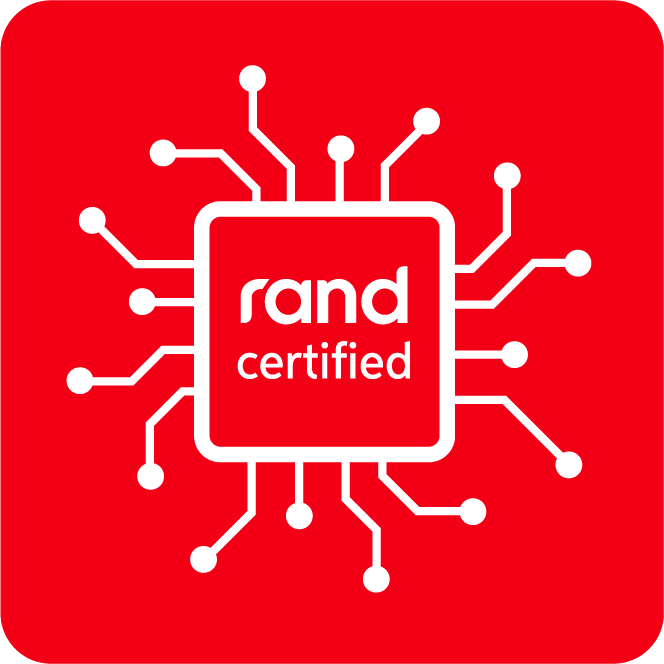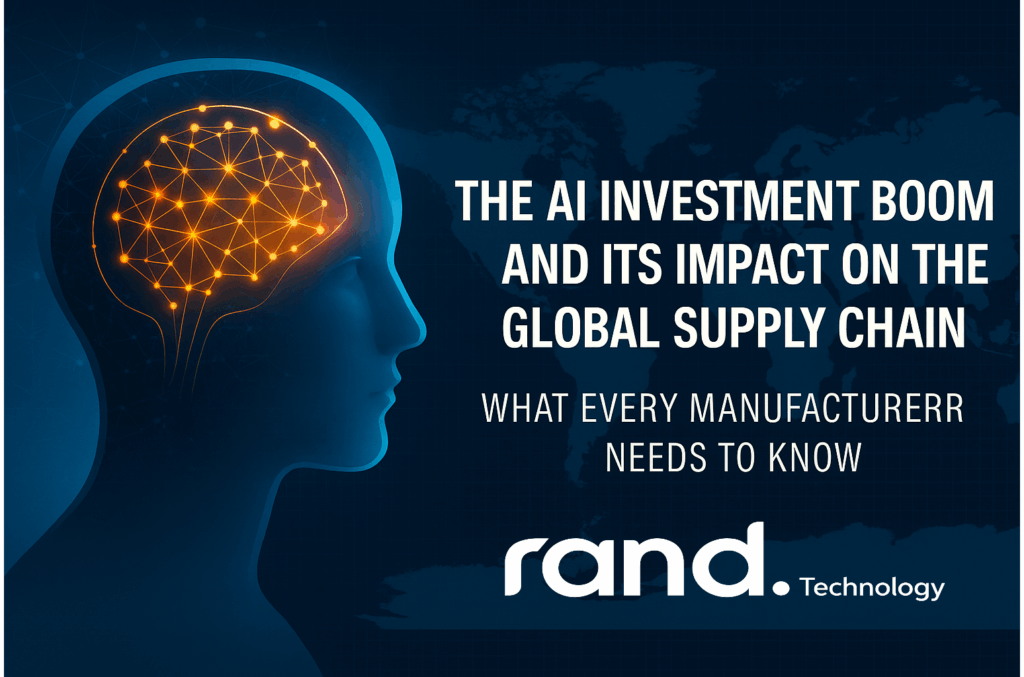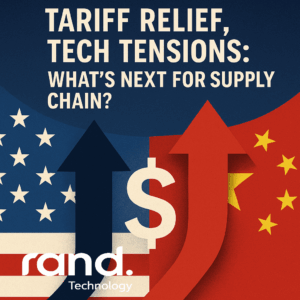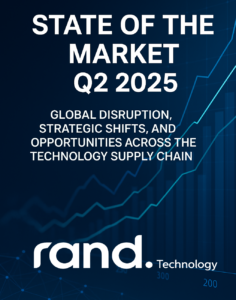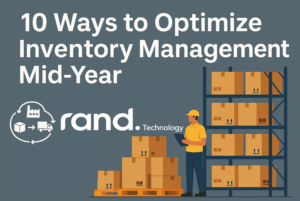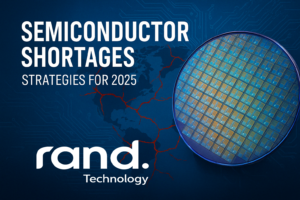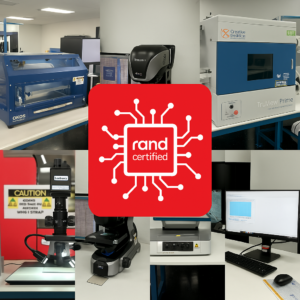Artificial intelligence is no longer a speculative investment or a futuristic promise—it is a defining force shaping the modern economy. As CFOs and CIOs shift budget priorities toward technology and infrastructure modernization, we are witnessing a wave of capital investment unlike any before. In 2025, 77% of CFOs plan to increase technology spending, and nearly half expect those budgets to grow by 10% or more. These commitments are not just changing how businesses operate but fundamentally restructuring the global electronic component supply chain.
At Rand Technology, we are positioned at the center of this transformation. With over three decades of experience in component sourcing, supply chain solutions, and engineering services, we understand the pressure manufacturers face when balancing rapid innovation with logistical reality. This blog explores how the AI boom impacts supply chains, what risks and opportunities lie ahead, and how manufacturers can adapt strategically.
The Surge in Technology Investment: Why It Matters
The post-pandemic economy has accelerated digital transformation across every sector. Artificial intelligence, machine learning, IoT, automation, and data infrastructure have become top priorities for organizations aiming to increase efficiency, gain a competitive advantage, and reduce long-term costs.
This explosion of investment has created ripple effects throughout the global supply chain, particularly for:
- AI acceleration hardware (GPUs, FPGAs, AI-specific processors)
- High-performance memory (DDR5, HBM, LPDDR)
- Specialized power management ICs
- Custom ASICs and SoCs
As demand outpaces supply, companies are navigating increased lead times, elevated component pricing, and greater volatility in availability. The result is a supply chain under pressure, with buyers racing to secure critical parts ahead of their competitors.
Rising Demand, Shrinking Availability
Tech giants and hyperscalers are committing billions to AI infrastructure, setting new benchmarks for procurement volume. With large players consuming inventory at an accelerated rate, availability for small and mid-sized manufacturers has diminished. One semiconductor firm alone recently committed hundreds of millions to secure advanced components through long-term supply agreements.
This creates a cascading effect in the broader supply chain:
- Extended lead times: Components that were once available in weeks are now booked months in advance.
- Price spikes: Commodity chips and specialty components alike have seen steep price increases.
- Allocation cycles: Manufacturers are now forced to ration inventory across customers, creating unpredictability.
The consequences are profound: Production delays, missed product launches, and cost overruns are becoming more frequent. Traditional procurement strategies are no longer sufficient for many OEMs and contract manufacturers.
Semiconductor Sovereignty and Geopolitical Tensions
Governments across the globe have launched semiconductor sovereignty initiatives to strengthen domestic capabilities. The race to secure semiconductor independence is reshaping global supply lines from the U.S. CHIPS Act to Europe’s IPCEI and China’s continued investment in homegrown fabs.
While these efforts promise long-term benefits, the short-term impact includes:
- Regional pricing disparities based on tax incentives, trade policies, and local capacity.
- Supply bottlenecks during the transitional build-out of new fabs.
- Export restrictions and licensing hurdles are complicating cross-border shipments.
These geopolitical dynamics introduce a new layer of complexity for sourcing professionals. Manufacturers must now evaluate part availability and pricing, as well as the regulatory and political risks of their supply chain dependencies.
Accelerated Obsolescence and the Risk of Waiting
In the past, buyers could afford to wait. Today’s market punishes hesitation. Component innovation cycles are shortening, and next-gen products can quickly make existing parts obsolete. At the same time, delaying purchases can lead to availability gaps or inflated prices during demand surges.
This creates a tricky balancing act:
- Buy too early: Risk sitting on excess inventory or parts that may not align with the final spec.
- Wait too long: Face allocation, backorders, or pay a premium on the broker market.
This is where experienced partners like Rand Technology bring value. Our market intelligence tools, global sourcing network, and in-house engineering services allow us to anticipate trends and advise customers on the best timing and channels for procurement.
Why Independent Distributors Are More Important Than Ever
In a volatile and accelerated market, flexibility is key. Independent distributors like Rand Technology serve as strategic allies for buyers navigating uncertainty. We provide:
- Access to constrained or EOL (end-of-life) parts
- Global reach across Asia, Europe, and the Americas
- Custom sourcing and testing solutions
- Real-time data on pricing, availability, and lifecycle forecasts
When authorized channels are out of stock or unable to meet lead times, we fill the gap—quickly, reliably, and with full quality assurance. This role is increasingly vital as traditional supply chain models fail to keep pace with the speed of AI-driven transformation.
Smart Sourcing Strategies for the AI Age
To adapt to this evolving landscape, manufacturers should consider adopting the following strategies:
- Value-Based Prioritization
- Focus resources on technology investments that directly drive business impact. Align procurement with your most critical innovation goals.
- Phased Modernization
- Avoid full-system upgrades that may be blocked by component shortages. Instead, roll out in phases to match supply availability.
- Diversified Sourcing
- Work with multiple partners, including independent distributors, to ensure redundancy during allocation cycles and regional disruptions.
- Inventory Risk Management
- Blend just-in-time practices with strategic stocking of high-risk components. Use data to determine which parts justify pre-buying.
- Proactive Market Intelligence
- Monitor investment trends, tech roadmaps, and geopolitical developments. Procurement must be forward-looking, not reactive.
Rand Technology supports these strategies with tailored services that empower procurement teams to move faster, smarter, and more confidently.
The Road Ahead: Technology and Cost Optimization Must Coexist
While tech investment is rising, so is the pressure to optimize costs. This duality defines today’s challenge: Invest in innovation, but don’t overspend. Be agile, but stay resilient. Move fast, but manage risk.
CFOs and CIOs no longer treat cost control and digital transformation as opposing forces. Instead, they invest in the tools and strategies that allow for both. This includes working with supply chain partners who offer:
- Transparency in pricing and availability
- Expertise in shortage management and EOL planning
- Customization in testing, sourcing, and logistics
- Proven quality systems and global certifications
At Rand Technology, we understand this balance. Our mission is to deliver value beyond the part—we provide foresight, flexibility, and solutions that align with your bottom line.
The New Normal in Supply Chain Management
The AI investment boom is not a temporary spike—it marks a structural shift in how technology is developed, deployed, and delivered. For manufacturers and supply chain leaders, this shift requires new thinking, new strategies, and new partnerships.
Those who adapt will thrive, confidently meeting production goals and market opportunities. Those who cling to outdated models risk falling behind in a market that waits for no one.
At Rand Technology, we are here to help you stay ahead—with global sourcing power, deep market insight, and a commitment to quality that never wavers.
Let us be your strategic sourcing partner in the age of AI.






